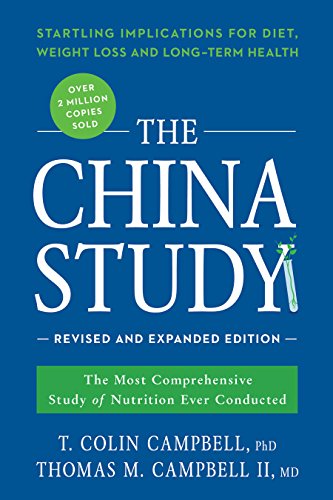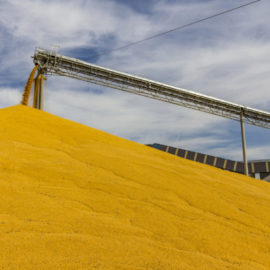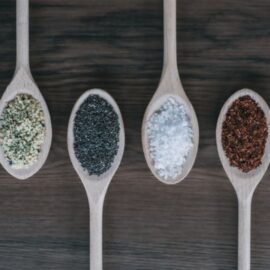

This article is an excerpt from the Shortform summary of "The China Study" by Colin Campbell. Shortform has the world's best summaries of books you should be reading.
Like this article? Sign up for a free trial here .
What foods contain high-quality proteins? How much high-quality protein should I eat? Are high-quality proteins better than low-quality proteins?
The term “high-quality protein” may be a misnomer. Learn why high-quality proteins are not necessarily healthier than low-quality, plant proteins, and may even be detrimental to your health.
High-Quality Protein: Myths and Facts
One thing we think we know about nutrition is that we need lots of protein to be strong and healthy. But we may not need as much as we think, and we probably don’t need animal protein at all.
Why Do We Need Protein?
Before we examine what high-quality proteins are, let’s look at why protein is important. Protein is a chemical made up of chains of hundreds of amino acids. It’s an essential part of our biological makeup—proteins function as enzymes, hormones, tissues, and transport molecules, among other roles.
Our bodies need to replace proteins when they get old and wear out. You can imagine a protein as a string of different colored beads, each color representing a different amino acid. When the string of beads breaks, we need to build a new one from new beads.
Our bodies make many of these “beads,” or amino acids, on their own, but there are eight they can’t produce. We need to consume these “essential” amino acids in order to replace some of our bodily proteins.
Protein “Quality”
The highest quality proteins are the ones that provide us with all eight of the amino acids our bodies can’t make themselves. The best high-quality proteins come from animal foods, particularly milk and eggs. The protein in plants is generally not high-quality protein because a single plant source usually lacks one or more of the eight essential amino acids.
Are High-Quality Proteins Better?
But the term “quality” is misleading. A protein can be “low quality” but still healthier than its high-quality peers.
“Low-quality” plant proteins are slower to synthesize into the proteins our body uses, but unlike animal proteins, they don’t increase our risk of disease. (We’ll look at how animal proteins contribute to disease development in the next chapter.) Animal proteins may be more efficient, but efficiency doesn’t always mean healthy. High-quality proteins may not be as healthy for you as low-quality proteins.
People worry that vegans (who don’t eat animal protein) don’t get the right amino acids, but as a group, plants contain everything we need. It’s not necessary to eat a huge quantity of plant proteins to reap their benefits, and we don’t need to meticulously plan each meal. As long as we’re eating a variety of plants, our amino-acid needs will likely be taken care of.
Our Infatuation with Animal Protein
If we can get all the protein we need from plants, why do we associate protein with animal foods? The outsize role played by animal proteins in our culture and our understanding of healthy eating has been formed by a little science and even more myths.
Attitudes About Meat
When protein was discovered in the 19th century, people already believed that eating animals increased their endurance and strength. Eating animals also symbolized our dominance over other creatures. Any evidence of the benefits of animal protein was welcome news to a society that took pride in its place at the top of the food chain.
Further, meat was expensive. Consequently, it was a status symbol: Eating meat demonstrated that you were rich and relying on plant foods demonstrated that you were poor. Some upper-class people believed that the lower classes were lazy because they didn’t eat as much meat as those who could afford it.
These attitudes helped make protein synonymous with meat, and we’ve inherited them, whether we realize it or not. Even today, beef is probably the first thing you think of when someone says “protein.” We still believe that people who don’t eat meat are anemic and weak and that animal protein is an essential part of a healthy diet. The term “high-quality protein” has also added to our confusion about the necessity of animal products. We want the best. Of course we want to eat high-quality proteins!
Study: The Dangers of High-Quality Proteins
During the 1960s and 70s, experts believed that a deficiency in animal-based protein was the primary cause of malnutrition. Dr. Campbell, author of The China Study, also believes that increasing protein options can be an important approach to alleviating malnutrition, particularly if people are malnourished because they rely on a single plant source, like potatoes, that may not have all the essential amino acids. But Campbell doesn’t believe that providing more high-quality protein is the only (or healthiest) way to improve nutrition in developing countries.
The example below illustrates the problems that come with tackling malnutrition by increasing high-quality protein intake.
The Philippines Project
When Campbell worked on this project in the 1960s, his goal was to help mothers understand what local foods would be the healthiest for their children. Because you can grow peanuts almost anywhere, Campbell and his fellow researchers decided to use peanuts as their primary protein source. But this was problematic.
The Problem with Plant-Based Proteins:
Peanuts in the area were contaminated with aflatoxin (AF), a toxin produced by mold. AF is considered one of the most dangerous known carcinogens.
Consequently, the focus of the project was now twofold: alleviate childhood malnutrition and solve the problem of AF contamination.
The Problem with Animal-Based Proteins:
Talking to a local doctor, Campbell found that children in the Philippines were dying of liver cancer before the age of 10. This was alarming. In the U.S., people usually don’t get liver cancer until they’re at least in their 40s.
Unexpectedly, the children who got liver cancer weren’t the most malnourished. They were from the wealthiest families, the ones who could afford to eat meat. They were eating more animal protein than most children in the country.
Common medical wisdom said that animal protein prevented diseases like liver cancer. What was going on? It was when he was contemplating this question that Campbell discovered the Indian study (referred to in the Introduction) that linked liver cancer with milk protein.
In the study, 100% of the rats dosed with the carcinogen AF and fed high-protein diets got liver cancer. 0% of the rats dosed with AF and fed low-protein diets got liver cancer.
These results were so contrary to the common wisdom that people didn’t believe them. One of Campbell’s prominent colleagues dismissed the study because he assumed that the Indian researchers had mixed up the cage numbers. What they had really shown, he insisted, was that the rats fed high-protein diets were the ones that didn’t get liver cancer, and the ones on a low-protein diet were the ones that did.
But Campbell had seen this pattern in humans, so he didn’t discount the validity of the study’s results. Further, while the Indian study demonstrated the problem with at least one animal-based protein, casein, it seemed to offer a solution to Campbell’s plant-based protein problem, AF contamination: If animal proteins activate AF, perhaps it didn’t matter if you consumed AF in peanuts if you avoided the animal foods that activate it. Maybe the AF in peanuts wasn’t as dangerous as everyone thought it was. Maybe casein was the real danger.
After reading this study, Campbell started his own research (discussed in the next chapter) to see if and how consuming protein leads to cancer.
Summary of Recommendations
- Eat plant-based proteins. These come in the form of fruits, vegetables, and whole grains.
- Avoid animal-based proteins. These come from meat, fish, eggs, and milk.
The term “high-quality proteins” may be a misnomer. Although protein is an essential part of a healthy diet, trying to include as many high-quality proteins as you can may be a recipe for disease.
———End of Preview———

Like what you just read? Read the rest of the world's best summary of "The China Study" at Shortform . Learn the book's critical concepts in 20 minutes or less .
Here's what you'll find in our full The China Study summary :
- Why animal proteins (meat, milk) might cause cancer, diabetes, and other diseases
- Why the medical institution is structured to hide the truth about disease and food
- The precise diet you'll need to eat to live longer and feel happier






